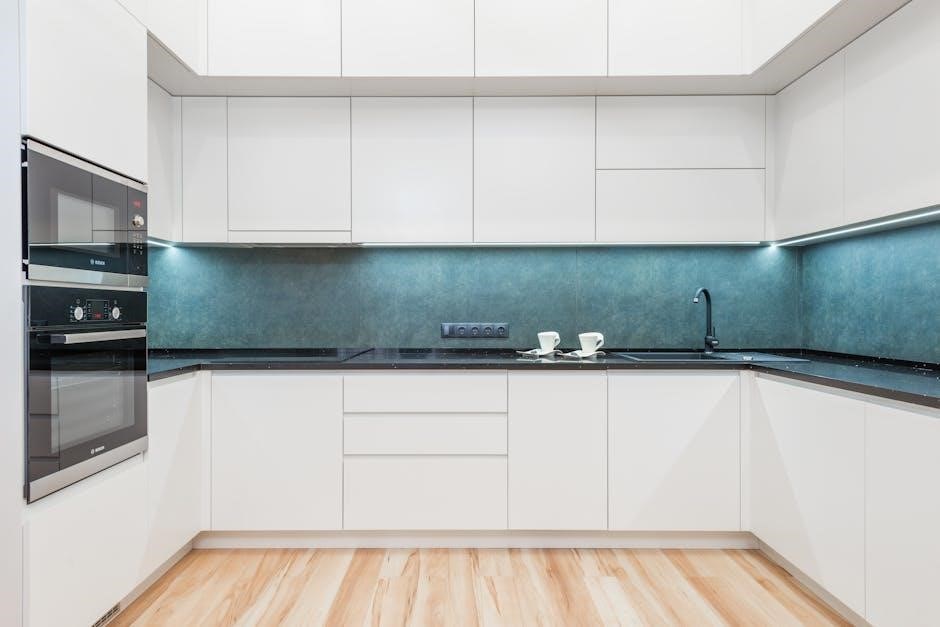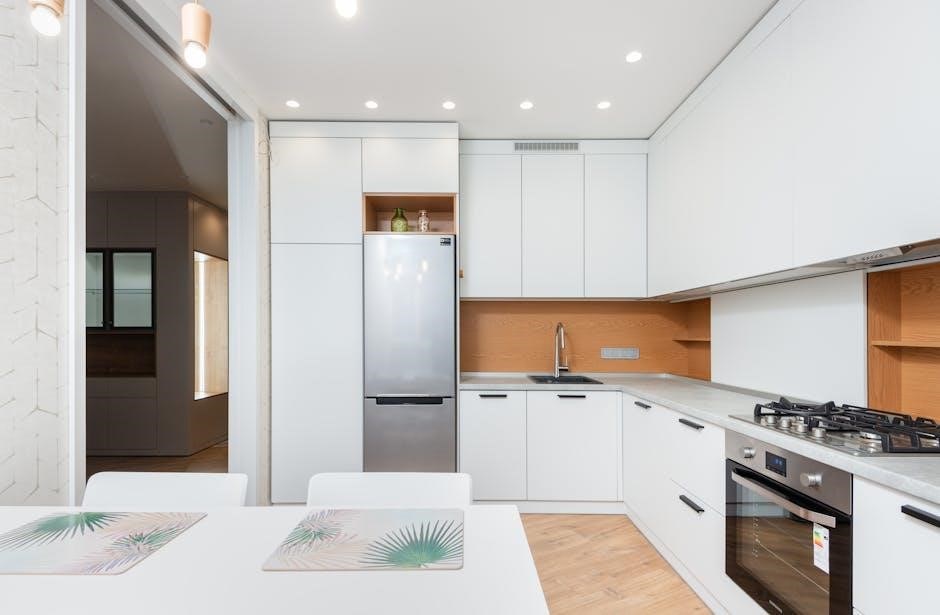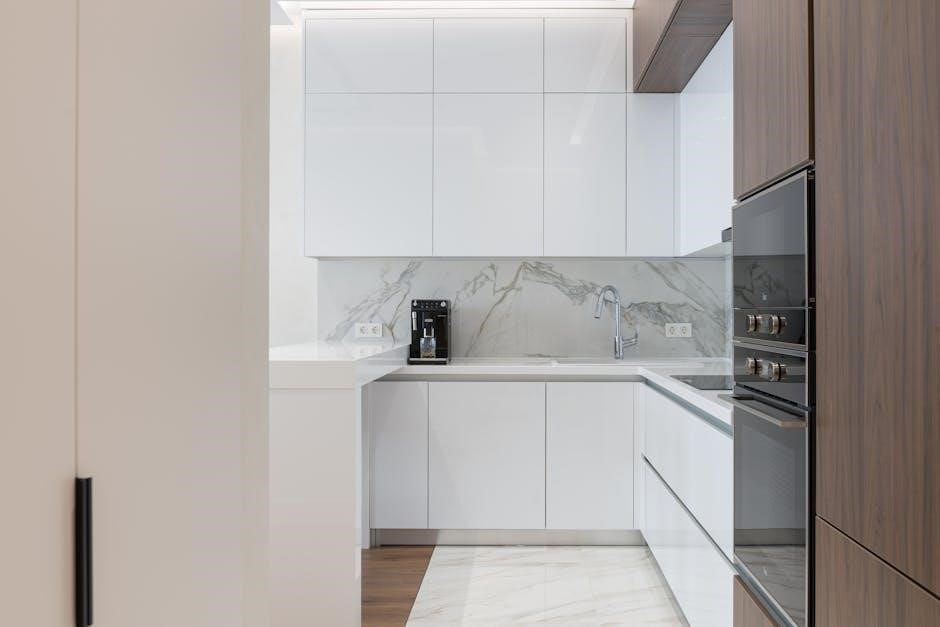Older Jenn-Air self-cleaning ovens require careful operation. Always consult the owner’s manual for model-specific instructions. Proper preparation is essential for effective and safe cleaning. Understand the oven’s features and cleaning settings.
Older Jenn-Air self-cleaning ovens represent a blend of innovative technology from their time. Understanding their operation requires consulting the original user manuals, as electronic controls and features may differ significantly from modern ovens. These older models often relied on high-temperature cycles to burn off food residue, requiring careful preparation and adherence to safety guidelines. Familiarizing yourself with the specific model’s instructions is crucial for effective cleaning and preventing damage to the appliance. Remember that these older ovens may lack the advanced sensors and safety features of newer models.
Understanding Self-Cleaning Cycle Basics
The self-cleaning cycle utilizes high temperatures to incinerate food residue. This process turns debris into ash, which can then be wiped away. It’s crucial to understand cycle duration and safety precautions.
How the Self-Cleaning Cycle Works
The self-cleaning cycle in older Jenn-Air ovens employs extremely high temperatures to burn away food residue. This process turns grease, spills, and baked-on messes into a fine ash. The oven heats up significantly, often reaching temperatures around 900°F (482°C), ensuring thorough cleaning. During this cycle, the oven door locks automatically for safety. The intense heat breaks down organic matter, leaving behind only ash, which is easily wiped away after the cycle completes and the oven cools down. This high-temperature cleaning eliminates the need for harsh chemicals.
Importance of the Owner’s Manual
The owner’s manual is crucial for operating older Jenn-Air self-cleaning ovens. It contains model-specific instructions for safe and effective cleaning. Refer to the manual to determine the appropriate cleaning time and settings. The manual provides safety precautions to avoid hazards during the self-cleaning cycle. It outlines procedures for preparing the oven, including removing racks and accessories. Troubleshooting tips in the manual can help resolve common issues. Following the manual ensures proper use of the oven and prevents damage. Always consult the owner’s manual before initiating the self-cleaning cycle.
Preparing the Oven for Self-Cleaning
Preparing your older Jenn-Air oven involves removing racks and loose debris. Wiping up spills prevents smoke and ensures effective cleaning. These steps are crucial before starting the self-cleaning cycle.
Removing Oven Racks and Accessories
Before initiating the self-cleaning cycle on your older Jenn-Air oven, it is crucial to remove all oven racks, broiler pans, and any other accessories from the oven’s interior. These items can become discolored or damaged during the high-temperature cleaning process. Removing them ensures that only the oven’s interior surfaces are subjected to the intense heat. This step helps to prevent any potential warping, discoloration, or damage to the racks and accessories, maintaining their integrity for future use and ensuring the oven cleaning is done effectively.
Wiping Up Loose Debris and Spills
Prior to starting the self-cleaning cycle in older Jenn-Air ovens, it is essential to thoroughly wipe up any loose debris, food particles, and spills from the oven’s interior surfaces; This step is crucial because the high temperatures during the self-cleaning cycle can cause these remnants to harden, burn, or produce unpleasant odors. Removing loose debris prevents potential smoke and ensures a more effective cleaning process; A damp cloth can be used to wipe down the oven walls, floor, and door, ensuring that all visible food residue is eliminated before the cycle begins.

Operating the Self-Cleaning Cycle
Operating the self-cleaning cycle on older Jenn-Air ovens involves setting the appropriate cleaning time, if applicable. Then, initiate and properly stop the cycle, following the manufacturer’s instructions for safety and optimal cleaning performance.
Setting the Cleaning Time (if applicable)
Some older Jenn-Air self-cleaning ovens allow users to manually set the cleaning time based on the level of soil. Consult your owner’s manual for specific instructions on how to adjust the cleaning time. A shorter time may suffice for light cleaning, while heavily soiled ovens benefit from a longer cycle. Selecting the correct time ensures efficient cleaning without unnecessary energy consumption. Always follow the manufacturer’s guidelines to prevent damage to the oven’s interior. This setting is crucial for optimizing cleaning results in older models.
Starting and Stopping the Cycle
To start the self-cleaning cycle on an older Jenn-Air oven, consult the owner’s manual for the specific button sequence. Ensure the oven door is securely locked before initiating the cycle. Once started, avoid opening the door until the cycle completes and the oven cools down. If necessary to stop the cycle prematurely, press the “Cancel” or “Clear” button, though this might not be possible on all models. Be aware that interrupting the cycle may leave residue. Always refer to the manual for emergency stopping procedures.

Safety Precautions
When using the self-cleaning cycle, prioritize safety. Ensure adequate ventilation to avoid inhaling fumes. Protect pets, particularly birds, as they are sensitive to these fumes. Never leave the oven unattended during the cleaning process.
Avoiding Fumes and Ventilation
The self-cleaning cycle generates high temperatures, which can release fumes. Always ensure proper ventilation by opening windows and turning on the kitchen exhaust fan. Avoid prolonged exposure to these fumes, as they can cause respiratory irritation. If you have respiratory issues, consider leaving the house during the cleaning cycle. Some birds are highly sensitive to oven fumes; move them to a well-ventilated area or another location. Never use oven cleaners during the self-cleaning cycle, as this can produce harmful gases. Always prioritize safety and well-being.
Protecting Pets, Especially Birds
The fumes emitted during the self-cleaning cycle can be hazardous, especially for pets. Birds are particularly susceptible due to their sensitive respiratory systems. Always relocate birds to a well-ventilated area or, ideally, to another house during the self-cleaning process. Ensure other pets, such as cats and dogs, are also kept away from the kitchen. Good ventilation is key; open windows and use exhaust fans. Monitor pets for any signs of distress, such as coughing or difficulty breathing. Prioritize their safety by taking these precautions.

Troubleshooting Common Issues
Older Jenn-Air ovens might present unique challenges. Addressing cleaning cycle failures and strange noises is crucial. Consult your manual for model-specific solutions. Consider professional help for persistent issues.
Oven Not Self-Cleaning
If your older Jenn-Air oven fails to self-clean, several factors could be responsible. First, ensure the oven temperature is below 400°F (205°C) before initiating the cycle, as some models require this. Verify that the oven door is fully closed and the lock mechanism is engaged. Check the control panel settings to confirm the self-clean cycle is correctly programmed. A malfunctioning temperature sensor or a faulty control board can also prevent the self-cleaning function from activating. Consult the owner’s manual for troubleshooting steps specific to your model or contact a qualified appliance technician for assistance.
Unusual Noises During Cleaning
During the self-cleaning cycle of an older Jenn-Air oven, some noises are normal due to high temperatures. However, unusual or excessively loud noises can indicate a problem. Popping or cracking sounds may occur as the oven’s porcelain components expand and contract with heat. A fan noise should be audible during the cycle, but if it’s excessively loud or absent, it could signal a malfunctioning fan motor. Grinding or scraping sounds may indicate debris interfering with the cleaning process. If unusual noises persist or cause concern, discontinue the self-cleaning cycle and consult a qualified technician.
Post-Cleaning Procedures
After the self-cleaning cycle, allow the oven to cool completely. Once cooled, wipe away any ash residue with a damp cloth. Ensure the oven is thoroughly ventilated before using it for cooking.
Cool Down Period
Following the completion of the self-cleaning cycle on your older Jenn-Air oven, it’s crucial to allow a sufficient cool-down period. The oven’s internal temperature reaches extremely high levels during the cleaning process, and attempting to access the interior prematurely can pose a significant burn risk. Keep the oven door securely closed throughout the entire cool-down phase, which can typically last for several hours, depending on the specific model and the duration of the cleaning cycle. Avoid opening the door to check on the progress, as this will disrupt the cooling process and potentially cause damage.
Wiping Away Ash Residue
Once the oven has completely cooled down following the self-cleaning cycle, a layer of powdery ash residue will likely remain on the interior surfaces. This ash is the byproduct of the high-temperature burning process that eliminates food particles and grease. To remove this residue, use a damp cloth or sponge to gently wipe down all interior surfaces of the oven. Avoid using abrasive cleaners or scouring pads, as these can damage the oven’s porcelain finish. For stubborn ash deposits, a mild solution of soap and water can be used. Ensure all soap residue is removed.
Alternative Cleaning Methods for Older Ovens
For older Jenn-Air ovens, consider alternative cleaning methods. This is especially important if the self-cleaning function is not working correctly. Explore oven cleaners and AquaLift technology, if applicable. Always proceed with caution.
Using Oven Cleaners (with caution)
When the self-cleaning cycle isn’t ideal for older Jenn-Air ovens, oven cleaners offer an alternative. However, exercise extreme caution. Ensure adequate ventilation by opening windows and using fans. Always wear gloves and eye protection to avoid skin and eye irritation. Apply the cleaner according to the product’s instructions, avoiding heating elements and sensitive areas. After the recommended time, thoroughly wipe away all traces of the cleaner with a damp cloth. Residue can produce fumes during future use. Consider using gentler, fume-free options to minimize risks.
AquaLift Self-Cleaning Technology (if applicable)
Some older Jenn-Air ovens may feature AquaLift technology. If your model has it, this offers a gentler cleaning method. First, remove any loose debris from the oven interior. Then, pour the specified amount of water into the oven bottom. Activate the AquaLift cycle, which typically runs for under an hour. The technology uses heat and water to loosen baked-on spills. After the cycle completes, wipe away the remaining water and loosened residue with a cloth or sponge. Always refer to your owner’s manual for specific instructions and water measurements for your model.

Maintenance Tips for Older Jenn-Air Ovens
Maintaining older Jenn-Air ovens involves regular cleaning and inspections. Promptly address spills to prevent buildup. Inspect and replace worn parts as needed. Refer to the owner’s manual for specific maintenance guidelines.
Regular Cleaning of Oven Interior
Regular cleaning of your older Jenn-Air oven’s interior prevents heavy buildup and ensures optimal performance. Wipe up spills immediately to avoid baked-on messes that are difficult to remove later. Use a mild detergent and warm water for routine cleaning, avoiding harsh chemicals that could damage the oven’s interior surfaces. For stubborn stains, consider a paste of baking soda and water, allowing it to sit before gently scrubbing.
Inspecting and Replacing Parts
Regular inspection of your older Jenn-Air oven’s parts is essential for maintaining its functionality and safety. Check the heating elements for any signs of damage, such as cracks or blisters. Examine the door seal for wear and tear to ensure proper insulation. Replace any worn or damaged parts promptly to prevent further issues. Consult the owner’s manual for compatible replacement parts or contact a qualified appliance repair technician for assistance with identifying and installing new components.
